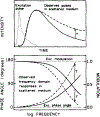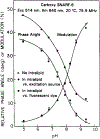Frequency-domain lifetime measurements and sensing in highly scattering media
- PMID: 34100577
- PMCID: PMC8147913
- DOI: 10.1016/0925-4005(96)80051-7
Frequency-domain lifetime measurements and sensing in highly scattering media
Abstract
For clinical chemistry, or for non-invasive sensing through skin, it is often necessary to obtain quantitative information in highly scattering media. We describe two simple methods for fluorescence lifetime measurements in highly scattering media, and in particular in an intralipid suspension. Lifetimes can be measured using an intensity decay law that accounts for the time delays and pulse-broadening effects of multiple light-scattering events in the intralipid. Alternatively, the phase and modulation measurements can be performed relative.to a reference fluorophore with a known lifetime. These approaches provide reliable lifetime data for a pH-sensitive fluorophore contained within a microeuvette 4 mm under the surface of the intralipid suspension. Fluorescence lifetime-based sensing is now recognized as a valuable methodology in clinical and analytical chemistry, and the possibility of lifetime-based sensing in turbid media has been demonstrated.
Keywords: Clinical chemistry; Fluorescence; Fluorescence spectroscopy; Frequency-domain fluorescence; Lifetime-based sensing; Non-invasive sensing; pH sensing; Photon migration; Time-resolved fluorescence.
Figures







Similar articles
-
Intensity measurements in scattering media.Sens Actuators B Chem. 1999 Nov 2;60(1):1-7. doi: 10.1016/S0925-4005(99)00234-8. Epub 2000 Jan 11. Sens Actuators B Chem. 1999. PMID: 31892766 Free PMC article.
-
Fluorescence lifetime spectroscopy for pH sensing in scattering media.Anal Chem. 2003 Aug 15;75(16):4325-9. doi: 10.1021/ac034059a. Anal Chem. 2003. PMID: 14632153
-
Measurement of the fluorescence lifetime in scattering media by frequency-domain photon migration.Appl Opt. 1999 Aug 1;38(22):4930-8. doi: 10.1364/ao.38.004930. Appl Opt. 1999. PMID: 18323983
-
Sensing of intracellular environments by fluorescence lifetime imaging of exogenous fluorophores.Anal Sci. 2015;31(4):275-85. doi: 10.2116/analsci.31.275. Anal Sci. 2015. PMID: 25864670 Review.
-
Recent Advances in Fluorescence Lifetime Analytical Microsystems: Contact Optics and CMOS Time-Resolved Electronics.Sensors (Basel). 2017 Dec 4;17(12):2800. doi: 10.3390/s17122800. Sensors (Basel). 2017. PMID: 29207568 Free PMC article. Review.
Cited by
-
Polarization sensing with visual detection.Anal Chem. 1999 Apr 1;71(7):1241-51. doi: 10.1021/ac981301i. Anal Chem. 1999. PMID: 10204029 Free PMC article.
-
Low-frequency modulation sensors using nanosecond fluorophores.Anal Chem. 1998 Dec 15;70(24):5115-21. doi: 10.1021/ac980876c. Anal Chem. 1998. PMID: 9868909 Free PMC article.
-
A water-soluble luminescence oxygen sensor.Photochem Photobiol. 1998 Feb;67(2):179-83. doi: 10.1562/0031-8655(1998)067<0179:awslos>2.3.co;2. Photochem Photobiol. 1998. PMID: 9487796 Free PMC article.
-
Intensity measurements in scattering media.Sens Actuators B Chem. 1999 Nov 2;60(1):1-7. doi: 10.1016/S0925-4005(99)00234-8. Epub 2000 Jan 11. Sens Actuators B Chem. 1999. PMID: 31892766 Free PMC article.
References
-
- Wolfbeis OS (ed.), Proc. 1st Eur. Conf. Optical Chemical Sensors and Biosensors, Graz, Austria, 12–15 April, 1992, Sensors and Actuators B, 11 (1993).
-
- Van Dyke K and Van Dyke R, Luminescence Immunoassay and Molecular Application, CRC Press, Boca Ratun, 1990.
-
- Lakowicz JR and Thompson RB, Advances in Fluorescence Sensing Technology, SPIE Proc, Vol. 1885, 1993.
-
- Durkin AJ, Jakumar S, Ramanujam N and Richards-Kortum R, Relation between fluorescence spectra of dilute and turbid samples, Appl. Opt, 33 (1994) 414–423. - PubMed
-
- Fantini S, Franceschini MA, Flshkin JB, Barbieri B and Granon E, Quantitative determination of the absorption spectra of chromophores in strongly scattering media: a light-emitting-diode based technique, Appl. Opt, 33 (1994) 5204–5213. - PubMed
Grants and funding
LinkOut - more resources
Full Text Sources
Other Literature Sources
